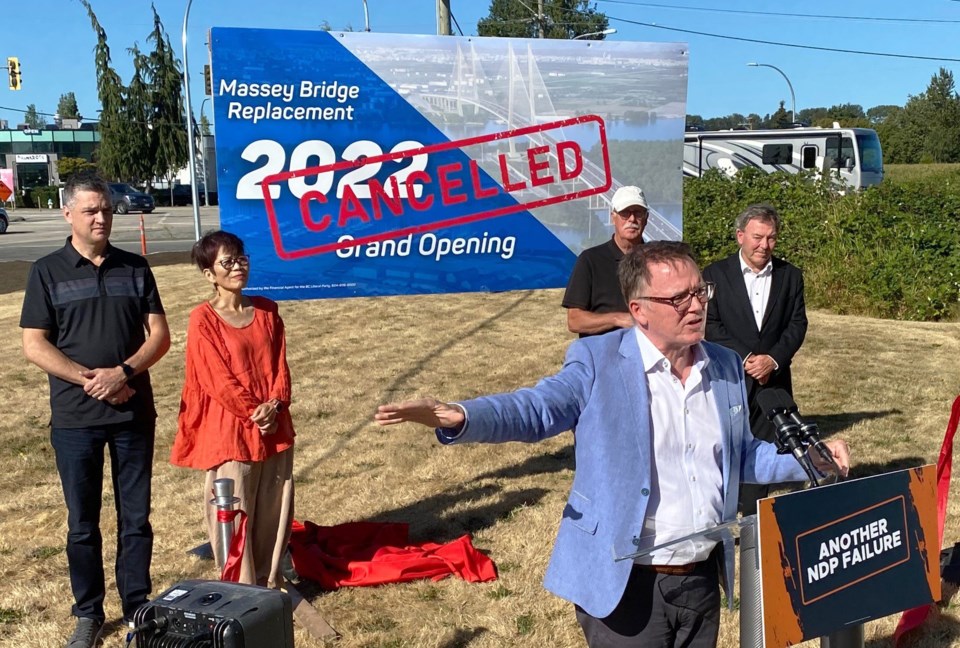Long-suffering Delta residents and many others commuting to and from south of the Fraser would have been driving on a new bridge by now, a structure that had more lanes and cost much less than the New Democrat government’s current George Massey Tunnel replacement tunnel project.
That was the message B.C. Liberal leader Kevin Falcon delivered outside the Delta Visitor Centre, located near the junctions of Highways 99 and 17, Wednesday morning in a mock ribbon-cutting event for “the opening of the bridge that should have been.”
It was aimed at slamming the NDP’s cancellation of the former Liberal government’s 10-lane bridge project, which Falcon pointed out was scheduled to open this summer.
Several other Liberal MLAs were on hand, including Delta South’s Ian Paton, as Falcon said the worst gridlock in B.C. “tortures” commuters every day, and will do so for years to come due to “petty politics” and the NDP’s continued mishandling of capital projects.
Falcon once again promised to cancel the current tunnel project if it’s still in the environmental assessment process by the next provincial election, adding the eight-lane tube will have less capacity, greater environmental impact and must undergo an environmental assessment for at least a couple of years.
“That, ladies and gentlemen, is the result of an NDP government that made what I believe is one of the worst capital decisions ever in the history of British Columbia. It is worse, I would argue, than the one billion dollars they were planning to spend on a museum in Victoria that nobody asked for and nobody wanted,” said Falcon.
Falcon noted the bridge project, which would have included various other highway improvements, at the time it received its environmental certificate, was projected to cost $2.6 billion, $900 million below the original project estimate, while taxpayers are looking at an estimated $4.15 billion for the immersed tunnel project. About $100 million was already spent when the bridge project was about to proceed.
Scheduled to open in 2030, the tunnel will have only two transit lanes as well as no HOV lanes or ability to accommodate future rapid transit, he said.
“Instead, what are we going to get? We’re going to get a government that plans on moving forward with an eight-lane tunnel that will provide the same number of commuter lanes, three lanes in each direction, that we currently have today when you’ve got the counterflow in place, meaning that we’re going to wait another decade, spend billions of dollars more to have the same number of commuter lanes that we have today. That is the real tragedy,” added Falcon.
Paton told the Optimist traffic is only getting worse with employers and employees choosing not to locate south of the Fraser due to the gridlock.
Diesel-burning trucks sitting in the gridlock makes it all the worse, he said.
“The other thing is for years there’s only really one major exit out of Ladner and that’s Ladner Trunk Road and Highway 17A. Everyone has to file out of Ladner to Highway 17A to go to the tunnel. With this new bridge concept, we were going to be able to come out of River Road at the east end and that road would have been extended underneath the bridge and come out by Vasey Road and by the new casino. So, people who live in that Captain’s Cove Marina Gardens area would have had another opportunity to get out of Ladner,” said Paton.
Following a presentation by a representative of the Highway 99 Tunnel Program this summer, Delta council said the tunnel project is lacking in some key areas that should be addressed before construction starts, including a second exit out of Ladner.
Council agreed to write to Premier John Horgan and Highways Minister Rob Fleming requesting the changes.
The new eight-lane underwater structure is to be located approximately 40 metres upriver from the existing George Massey Tunnel, which is to be decommissioned and removed once the new tunnel is open.
A Detailed Project Description is to be ready by next summer.
According to the province, the project is subject to a provincial environmental assessment, but does not require a federal environmental assessment.




